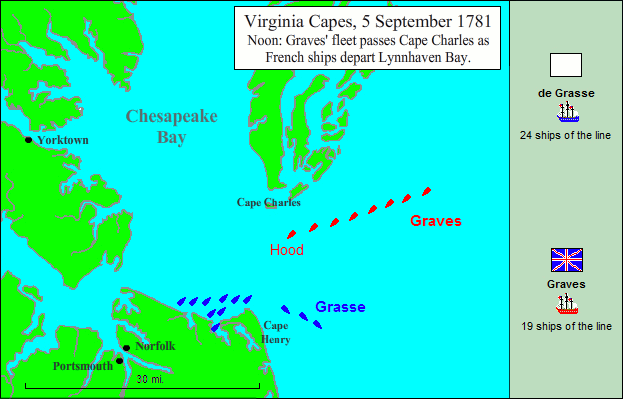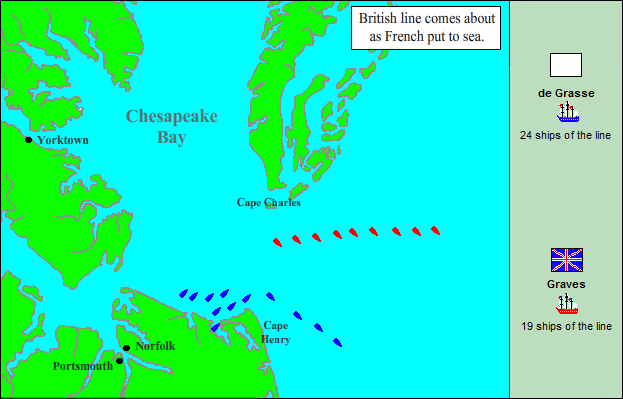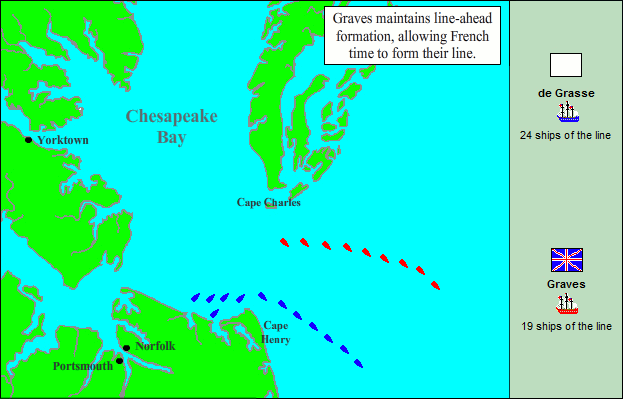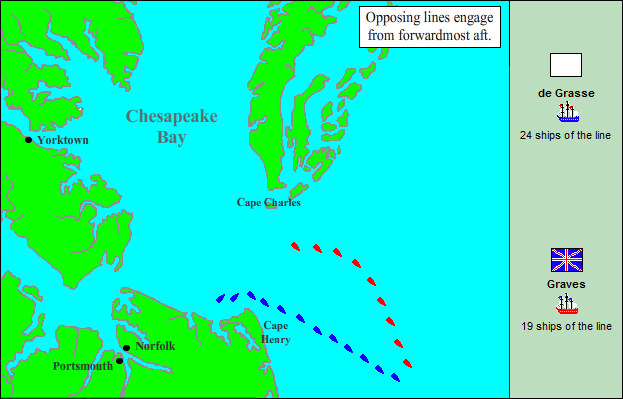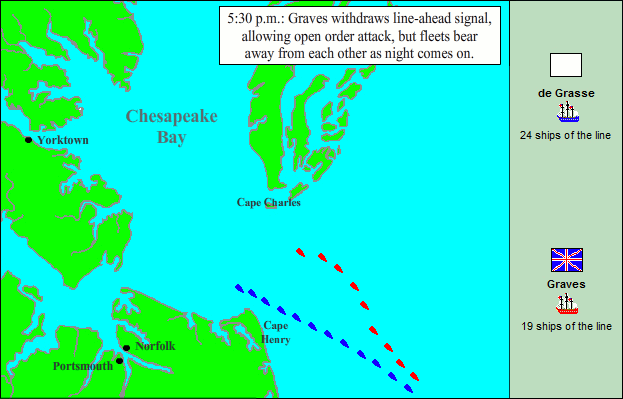The Virginia Capes
We prepared to move down and pay our old acquaintance, the British, at Yorktown, a visit. I doubt not but their wish was not to have so many of us come at once as their accommodations were rather scanty.
–Connecticut soldier William Plumb Martin
While Cornwallis settled in at Yorktown in hopes Clinton might join him, General Washington was eager to make the Hudson and Manhattan the seat of war. The last two years had seen a full measure of futility and frustration on the northern front as the American commander-in-chief made a show of “besieging” Clinton’s army on Manhattan, as if his 3,500 ragamuffins could legitimately hold Clinton’s 14,500 well-trained, well-fed, and well-led veterans with a fleet to back them up. Despite the slashing strokes at Stony Point and Paulus Hook, Washington had been utterly unable to hurt Clinton in any significant way. He owed his hold on the Highlands at least in part to Henry Clinton’s inertia. Indeed, the condition of his army in the spring of 1781 was as desperate as it had been in the winter of Valley Forge. His men were threadbare, ill-shod, and on lean rations. When they had been paid at all, it had been in Continental scrip. A man might roll cartridges in a Continental dollar, but he couldn’t buy anything with it since it was all but valueless (hence the phrase “not worth a Continental”). It is not hard to understand why his army leaked deserters steadily. What is astonishing is that so many held on with the Virginian. In April Washington wrote candidly to Congress, “We are at the end of our tether.” His men were more eager to march on their own Congress in Philadelphia than on Parliament in London. Indeed, last January desperate Continentals of the Pennsylvania Line had very nearly done so, soon joined in mutiny by soldiers of the Jersey Line. The men felt, not without reason, that they had been neglected by Congress and abandoned by their country. For a time the army that the British could not quite defeat was at the point of dissolving in disgust. In the end, the army got some small relief from Congress, mainly in the form of furloughs home, and when Washington hanged two of the most active mutineers, most of his men returned to the ranks. Few believed that they had received anything like justice for their service and sacrifice, but, as one put it, the men had no wish to be “Arnolds.”
The one thing that was different in this difficult spring was a French fleet and a French army. These represented hope and possibility for the American cause, though for the moment these instruments were not accomplishing much. The French fleet and the 4,000-man garrison at Newport remained hemmed in by British squadrons, and for the time being awaited events and reinforcements. But among the French Washington had found one ally he trusted, Jean Baptiste Donatien de Vimeur, Comte de Rochambeau. Seven years Washington’s senior and a tested veteran of Europe’s imperial struggles, he brought experience and ability to the American cause–not to mention troops, arms, ammunition, supplies. More than this, though, Rochambeau was intelligent, even-tempered, flexible, and cooperative, qualities not always found in general officers. In June Washington and Rochambeau conferred (through interpreters, as Rochambeau spoke no English) and agreed, despite the Frenchman’s serious reservations, to a combined operation to pry Henry Clinton loose from New York. Rochambeau sent the fleet on to Boston where it might be more secure and marched his army out of Newport and down to New York in the first part of July. By the time the local militia came in at the end of the month, the Franco-American force counted 9,000 of all arms, half French and half American. Throughout July and into August Washington and Rochambeau probed the British defenses and sparred in a desultory way with the Redcoats, but in the end Rochambeau’s reservations proved valid. The place was too strong, too well defended. They might smash their armies on Manhattan’s granite, but they could not drive Clinton from the island. In the middle of August, however, came a dispatch that would make Henry Clinton and New York a moot point for the time being. The Comte de Grasse was under sail from the West Indies with twenty-nine ships of the line and transports carrying 2,500 troops. He was headed for the Chesapeake and would arrive later that month.
Washington, with some reluctance, abandoned his operations against New York and made ready to seize the opportunity presented by a French fleet in the Chesapeake Bay. He would hold the Highland posts with a small detachment under William Heath. (Heath had been in service capably since the first day of the American war back in the spring of ’75.) With the bulk of his army and all of Rochambeau’s he meant to march overland with all deliberate speed. Once on the York Peninsula Washington might bring Cornwallis to battle with the odds in his favor at last. The risks in such a campaign were serious. If Clinton anticipated Washington’s move and moved quickly enough himself, he might easily overwhelm Heath’s 2,500. Then, too, he might simply ignore Heath and fall on the Franco-American columns strung out across the Jersey countryside. Much depended on Grasse and French control of the sea. If the tough and battle-tested British tars commanded the mouth of the Chesapeake, Cornwallis could be heavily reinforced or brought off safely and all the allies’ hard marching would go for naught. Finally, if it were done, it were well it were done quickly. Admiral de Grasse and the troops under General St. Simon could remain in the Chesapeake area no later than 15 October.
Washington went to work with a will and with astonishing speed. News of the French fleet’s destination reached Washington on 14 August. Five days later his army was already on the march into New Jersey. Of course, it was no easy thing to disengage in the face of a superior force, but Washington seemed to have taken a good reckoning of his foe. If Clinton was wary of a Franco-American attack on New York, Washington would give him plenty to think about. False orders were drafted and allowed to fall into enemy hands. Work details cleared and repaired roads in northern New Jersey. Great bread-baking ovens were built in full view of the British camp. While Clinton was considering the attack he believed imminent, Washington was shuttling both armies over the Hudson. By 25 August all but Heath’s holding force were on the west bank unmolested. A French officer wondered aloud about Clinton’s astonishing “indifference and lethargy” but could not help but be relieved. Washington was about to steal a long march on the enemy. His planning had been thorough, thoughtful, and calculating. His staff frankly marveled at his mastery of detail. Now all his men had to do was step out briskly and cover ground for the Delaware River. Clinton remained under Washington’s spell until September when he finally wrote Cornwallis that Washington’s southern movement was not a feint after all. On that day Washington’s columns were already swinging through Philadelphia and pushing on toward Elkton at the northern reach of the great bay.
Even as Washington was pressing his columns south from the northern reach of the Chesapeake, Admiral de Grasse was sailing north from the Caribbean toward his juncture with Lafayette at the southern end of the bay. The French admiral had been at sea since 5 August, and Washington was looking for his arrival with acute anxiety. Nor was Washington the only man in search of the French armada. Admiral Sir Samuel Hood in command of the British Caribbean squadron had put to sea from Antigua soon after Grasse, and though he had only fourteen ships of the line, he meant to catch him. There were only two places really Grasse could go–New York or the Chesapeake. Hood reached the mouth of the bay on 25 August, found it empty, and then crowded on sail for New York. As it happened, Grasse had put in at Havana on his way north and was five full days behind Hood. When Grasse’s ships reached the bay on 30 August, they dropped anchor quite undisturbed. Washington was still a long way to the north, but it was as if he could hear with his own ears the rattling of anchor chains at the mouth of the bay. When Rochambeau reached Chester, he was frankly astonished to see Washington, a man of studied calm and even icy self-control, actually whirling and waving his hat on the dock. There were more wonders as Washington embraced the Frenchman and danced him around in a great bear hug. Grasse’s 29 ships now held the mouth of the bay, and St. Simon’s 2,500 soldiers in their brilliant white uniforms and bright facings, were even then coming ashore. Once they linked up with Lafayette’s army at Williamsburg, Lord Cornwallis was trapped. Unless the British navy could blast its way into the bay, Lafayette and St. Simon would hold Cornwallis until Washington could come down for the kill.
The Royal Navy was not long in making the attempt. Hood, having found the bay empty, had sailed on to New York to report to his superior, Admiral Samuel Graves. Graves now knew that the French fleet was headed for American waters; its strength and destination, though, remained in doubt, and so did Graves’ resolve. Hood was a fighter, however, and managed to persuade Graves to put to sea in search of the enemy. Though Graves took his time, by 1 September the first of his nineteen ships crossed the bar at Sandy Hook and headed south. As the dawn of 5 September was breaking over Cape Charles at the mouth of the Chesapeake, they found what they were looking for: the masts of the French fleet snuggled into Lynnhaven Bay on the north shore of Cape Henry. Grasse might have made his fight right where he was at the mouth of the bay, but he was well aware that Admiral de Barras and the Newport fleet (with Rochambeau’s siege guns) were en route. Unwilling to give the British an opportunity to intercept Barras, Grasse resolved to put to sea on the turn of the tide. It was noon then before Grasse’s 29 ships slipped their cables and lumbered out to sea. For a battle that was about to decide the fate of a continent, the contest was shaping up as a rather leisurely affair. Grasse’s ships sailed out past Cape Henry to the southeast and took an hour or more to form up in conventional “line-ahead” fashion. Graves followed politely on a parallel tack, much to the seething disgust of Hood now in the rear of the British line. It was three o’clock before Graves hoisted the signal to give battle and the opposing lines began to close at about a thirty-degree angle.
There was no leisure now on the clamorous gun decks of the warships as the lead elements of the opposing lines drew within range. Given the French superiority in both numbers of ships and weight of fire, the British were getting the worst of the exchange. At any point Graves might have pulled his ships out of line and taken a chance on falling on the French center in force. It was a risk, but only a bold victory could save Cornwallis. Indeed, at 5:30 Graves took down the line-ahead signal, but by that time the battle was virtually over–a standoff. Only eight British ships and fifteen French had a serious hand in the fighting. All of these had been shot up, but only one was lost–HMS Thunderer, which sank off Cape Henry two days later. Considering the enormous firepower available to the combatants and the profound stakes, the Battle of the Virginia Capes had been more sea skirmish than sea battle. The two fleets tacked into the open sea in sight of one another for the next five days, but there was no more fighting. Eventually admitting defeat, Graves sailed off to the north. Grasse returned to the bay on 10 September to discover that Barras and the Newport fleet had slipped in behind him and were already putting men and guns ashore on the James River. Back in the spring, Sir Henry Clinton had warned Cornwallis of the grave dangers of his move into Virginia. He had likewise warned his staff that loss of the Chesapeake, even for two days, “may catch us in very critical movements.” With the French fleet at his back, Lafayette at Williamsburg, and Washington on the march, Lord Cornwallis was now well and truly caught.
Washington and Rochambeau reached Williamsburg on 14 September. They had stopped briefly at Washington’s Mount Vernon home, a place the general had not seen in six long years. Their armies, however, were strung out behind them over a great stretch of countryside. The allied vanguard was now moving down the bay from Head of Elk and the main body pushing on to Baltimore and Annapolis, where Grasse’s frigates would carry them on to Williamsburg. Still another column under Benjamin Lincoln was on the march overland from Baltimore. It had been exactly one month since Washington resolved to seize the day in Virginia. Now that the decisive opportunity was at hand, he wanted the business pushed forward with the “most unabating ardor.” As he wrote Lincoln from Williamsburg, “Every day we lose now is comparatively an age. As soon as it is in our power with safety, we ought to take our position near the enemy. Hurry on then my dear sir, with your troops on the wings of speed… Lord Cornwallis is improving every moment to the best advantage, and every day that is given him to make his preparations may cost us many lives to encounter them.” By 26 September the allied hosts were at last gathered at Williamsburg–16,000 in sum, more men than Washington had commanded since that disastrous day on Long Island back in ’76 when Lord Howe had got much the better of him. Now there was to be a reckoning with Lord Cornwallis and his 7,000 veterans. Two days later the allies marched out of Williamsburg in two columns under a bright autumn sky and began tramping down the peninsula to Yorktown. They were fit, confident, in high spirits. One in the American ranks, Joseph Plumb Martin, a young Connecticut soldier who had been in the fight since the first, caught the mood of the march with edgy wit: “We prepared to move down and pay our old acquaintance, the British, at Yorktown, a visit. I doubt not but their wish was not to have so many of us come at once as their accommodations were rather scanty. They thought, ‘the fewer the better cheer.’ We thought, ‘the more the merrier.’ We had come a long way to see them and were unwilling to be put off with excuses.” About six miles from Yorktown, the French filed off to the left and the Americans to the right. That night the Redcoats could see a great arc of their visitors’ campfires just two miles from their lines. The American right rested on the river to the east and the French left on the river to the west.
If Cornwallis had had a free hand to choose ground to withstand a siege, Yorktown would hardly have been his choice. Yorktown proper stood on a plateau only thirty feet above the river. Ravines cut the plateau and ran down to the river. Cornwallis’ flanks rested on a sluggish creek and boggy ground northwest of town and Wormley Creek to the southeast. Neither were formidable barriers to an assault. Directly south of the town was a piney rise called Pigeon’s Hill, or sometimes the Pigeon Quarter. Cornwallis’ defense depended on two lines. The outer line posted three redoubts in the center on Pigeon Hill, some 1,200 yards from the town. The Star, or Fusiliers’, Redoubt anchored the British right; this work backed up to the river northwest of town. Two more redoubts, called simply Nine and Ten, anchored the British left on the river southeast of town. An inner line of earthworks and trenches ran in an arc around the town some three or four hundred yards out, but neither trenches nor works were complete by the time the allies arrived to invest the place. Across the river, at Gloucester Point, a single line backed by three small redoubts ran from bank to bank. The line faced due north and was held by just 700 under Tarleton. When Washington rode forward to do a full evaluation of Cornwallis’ defenses, he was frankly astonished. Six years of war had given him an engineer’s eye for defense. Cornwallis’ response to his desperate predicament, Washington thought, was “passive beyond conception.”
What Cornwallis did next was even more astonishing. When dawn broke on 30 September, allied pickets discovered that the outer line of British redoubts in the Pigeon Quarter had been quietly abandoned in the night. As Dr. James Thacher, a frontline surgeon of long service, confided to his diary, the British surrendered without a fight a strong post which might have cost the allies “much labor and many lives to obtain by force.” Cornwallis did have his reasons, chief of which was an assurance from Clinton in a dispatch the day before that 23 ships of the line and 5,000 fighting men would soon sail from New York to lift the siege. Cornwallis wrote in response, “I have ventured these last two days to look General Washington’s whole force in the face… and have the pleasure to assure your Excellency that there is but one wish throughout the army, which is that the enemy would advance… I shall retire this night within the works, and have no doubt if relief arrives in any reasonable time, York and Gloucester will both be in the possession of His Majesty’s troops.” Relief from New York would never reach Yorktown, but Cornwallis would get his “one wish”: over the next two weeks the enemy would advance and advance relentlessly.

